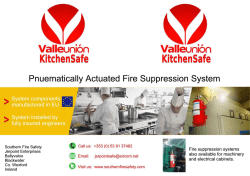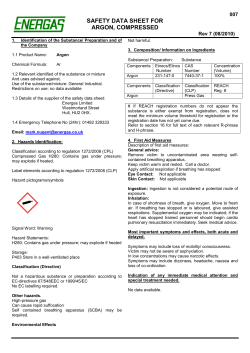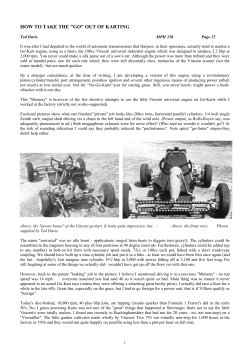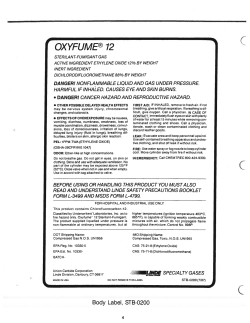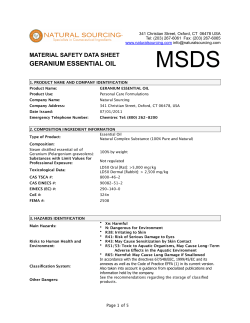
DRAFT AC 21-18 Design and maintenance of containers:
DRAFT ADVISORY CIRCULAR AC 21-18 Design and maintenance of containers: transportation of live aquatic animals using oxygen or compressed air v1.0 – October 2014 Project Number: CS 13/12 DESIGN AND MAINTENANCE OF CONTAINERS: TRANSPORTATION OF LIVE AQUATIC ANIMALS USING OXYGEN OR COMPRESSED AIR Advisory Circulars are intended to provide advice and guidance to illustrate a means, but not necessarily the only means, of complying with the Regulations, or to explain certain regulatory requirements by providing informative, interpretative and explanatory material. Advisory Circulars should always be read in conjunction with the relevant regulations. Audience This Advisory Circular (AC) applies to: persons responsible for the design of containers for transporting live aquatic animals, using compressed oxygen or compressed air to aerate the water, for use on Australian registered aircraft or foreign aircraft operating from or within Australia Certificate of Registration or Certificate of Airworthiness holders for aircraft that carry containers with a compressed oxygen or compressed air aeration system installed Persons or organisations holding an authorisation as an approved design organisation. Purpose This AC provides guidance on a range of matters that need to be considered to ensure that a compressed oxygen or compressed air system, carried in an aircraft for the purposes of carriage of live aquatic animals, will not be a threat to the safety of the aircraft while either on the ground or in flight. The requirements of International Civil Aviation Organization (ICAO) Special Provision (SP) A202—ICAO SP A202—of the ICAO Technical Instructions, as reproduced in this AC, have been agreed to and accepted by Australia. For further information For further information on this AC, contact CASA’s Airworthiness and Engineering Standards Branch (Telephone 131 757) or email aircraft.certification@casa.gov.au Unless specified otherwise, all subregulations, regulations, subparts, parts and divisions referenced in this AC are references to the Civil Aviation Safety Regulations 1998 (CASR). AC 21-18 v1.0 DRAFT October 2014 Page 1 DESIGN AND MAINTENANCE OF CONTAINERS: TRANSPORTATION OF LIVE AQUATIC ANIMALS USING OXYGEN OR COMPRESSED AIR Status Version 1.0 AC 21-18 v1.0 Date 20/03/2014 Details Initial issue of this AC DRAFT October 2014 Page 2 DESIGN AND MAINTENANCE OF CONTAINERS: TRANSPORTATION OF LIVE AQUATIC ANIMALS USING OXYGEN OR COMPRESSED AIR Contents 1 2 3 4 5 Reference material 4 1.1 Acronyms 4 1.2 Definitions 4 1.3 References 4 Background 6 2.1 Introduction 6 2.2 Airline requirements 6 2.3 ICAO requirements 7 Oxygen system components 8 3.1 Cylinder design requirements 8 3.2 Cylinder storage requirements 8 3.3 Oxygen lines 9 3.4 Fittings 9 3.5 Shut-off valves 10 3.6 Regulators and minimum pressure retention valves 10 3.7 Gauges and flow meters 10 Transport containers 11 4.1 Design and Construction 11 4.2 Ventilation 12 4.3 Physical constraints 12 4.4 Marking 12 4.5 Placards 12 4.6 Testing 13 Certification and maintenance 15 5.1 Granting of certification 15 5.2 System of Maintenance 15 5.3 Transport documentation 16 AC 21-18 v1.0 DRAFT October 2014 Page 3 DESIGN AND MAINTENANCE OF CONTAINERS: TRANSPORTATION OF LIVE AQUATIC ANIMALS USING OXYGEN OR COMPRESSED AIR 1 Reference material 1.1 Acronyms The acronyms and abbreviations used in this AC are listed in the table below. Acronym Description AC Advisory Circular AS Australian Standard CASA Civil Aviation Safety Authority CASR Civil Aviation Safety Regulations 1998 ICAO International Civil Aviation Organization SP Special Provision 1.2 Definitions Terms that have specific meaning within this AC are defined in the table below. Term Definition Shippers of dangerous goods – ‘shippers’ A person who consigns dangerous goods for carriage on an aircraft. 1.3 References Regulations Regulations are available on the ComLaw website http://www.comlaw.gov.au/Home Subpart 21.J—Approved design organisations. Subpart 21.M—Designs of modifications of, and repairs to, aircraft, aircraft engines, propellers and appliances. ICAO ICAO Doc 9284–AN/905 and ICAO Doc 9284-AN/905 SUPPLEMENT, 2013-2014 Edition— Technical Instructions for the Safe Transport of Dangerous Goods by Air. Supplementary special provision A202. Available at http://www.icao.int/safety/DangerousGoods/Pages/default.aspx AC 21-18 v1.0 DRAFT October 2014 Page 4 DESIGN AND MAINTENANCE OF CONTAINERS: TRANSPORTATION OF LIVE AQUATIC ANIMALS USING OXYGEN OR COMPRESSED AIR Advisory material CASA’s advisory material is available at http://www.casa.gov.au/scripts/nc.dll?WCMS:STANDARD::pc=PC_90902 AC 92-5(0)—Use of Compressed Oxygen: Carriage and Consignment of Live Aquatic Animals for Transport by Air. Standards Standards are available from SAI Global at http://infostore.saiglobal.com/store/ AS 2030.1–2009—Gas cylinders – General requirements. AS 2030.5–2009—Gas cylinders – Filling, inspection and testing of refillable cylinders. AS 2473.1–2006—Valves for compressed gas cylinders AS 3840.1–1998—Pressure regulators for use with medical gases. AS 4267–1995—Pressure Regulators for use with industrial gas cylinders. SAE AIR 1392:1998 (R2013)—Oxygen System Maintenance Guide. AC 21-18 v1.0 DRAFT October 2014 Page 5 DESIGN AND MAINTENANCE OF CONTAINERS: TRANSPORTATION OF LIVE AQUATIC ANIMALS USING OXYGEN OR COMPRESSED AIR 2 Background 2.1 Introduction 2.1.1 Live aquatic animals can be transported at relatively high densities by bubbling oxygen or air from a compressed gas cylinder through the water in which they are being transported. This technique makes long distance air transport feasible by providing life support for aquatic animals. Testing and experience in operation have shown that zero mortality rates are regularly achieved. 2.1.2 There is currently no information or guidance for the design and construction of oxygen systems that are to be fitted to, or carried on, aircraft other than for purposes of supplemental oxygen use. 2.1.3 The design requirements of this AC have been evaluated during flight trials and demonstrated to meet the requirements of the ICAO documents in a safe and practical manner. Note: Oxygen is neither explosive nor flammable. However, given the right circumstances oxygen can assist combustion of materials that might otherwise be considered non-flammable. Extreme care must be taken with the cleanliness of the system and that no oils or grease are used. 2.1.4 The guidance contained in this AC is for transportation of all live aquatic animals and is intended to satisfy ICAO standards for international transport. While it is recognised that this AC may be restrictive to some operators with systems not used in conjunction with passenger carrying or international cargo flights, alternate systems may be accepted by CASA. This includes systems that are not a single unit incorporating oxygen systems and tanks. 2.2 Airline requirements 2.2.1 Airlines may have additional requirements for the shipping of dangerous goods and should be contacted directly in order to determine their specific requirements. AC 21-18 v1.0 DRAFT October 2014 Page 6 DESIGN AND MAINTENANCE OF CONTAINERS: TRANSPORTATION OF LIVE AQUATIC ANIMALS USING OXYGEN OR COMPRESSED AIR 2.3 ICAO requirements 2.3.1 The requirements of the ICAO Technical Instructions Special Provision A202 (ICAO SP A202) have been agreed to and accepted by Australia. Systems designed in accordance with the guidelines in this AC should satisfy the necessary airworthiness requirements for transportation of live aquatic animals under ICAO SP A202, reproduced below. ICAO Technical Instructions SP A202 For the purpose of providing life support for aquatic animals during transport, the appropriate authority of the States of Origin, of Destination and of the Operator may approve the carriage of cylinders containing oxygen compressed, UN 1072 and air, compressed UN 1002, with the valve(s) open to supply a controlled quantity of oxygen or air through a regulator into water containing the aquatic animals. The cylinder or cylinder valve must be fitted with a self-sealing device to prevent uncontrolled release of oxygen or air should the regulator malfunction or be broken or damaged. The oxygen or air cylinder must meet those parts of Packing Instruction 200 which apply, except for the need for valves to be closed. In addition, the following conditions apply as a minimum: a. b. c. d. e. f. g. the water container with the attached oxygen and/or air cylinder (transportation unit) must be engineered and constructed to withstand all anticipated loads. No more than two cylinders of which a maximum is one cylinder of oxygen are permitted the water container must be tilt tested to an angle of 45º in four directions from the upright for a 10 minute minimum duration in each direction with the oxygen supply operating, without leakage of water the oxygen or air cylinder and regulator must be restrained and protected within the equipment the oxygen or air regulator used must have a maximum flow rate of not more than five (5) litres per minute the oxygen or air flow rate to the container must be limited to that sufficient to provide life support to the aquatic animals the quantity of oxygen or air provided must not exceed 150% of the oxygen or air required for the normal duration of air transport only one cylinder may be carried for each 15 cubic metres of gross cargo hold volume. In no circumstances may the rate of oxygen or air flow from the cylinder exceed one (1) litre per minute per five (5) cubic metres of gross cargo hold volume. AC 21-18 v1.0 DRAFT October 2014 Page 7 DESIGN AND MAINTENANCE OF CONTAINERS: TRANSPORTATION OF LIVE AQUATIC ANIMALS USING OXYGEN OR COMPRESSED AIR 3 Oxygen system components 3.1 Cylinder design requirements 3.1.1 All cylinders must meet the requirements of ICAO SP A202. In addition to ICAO SP A202, cylinders must meet the following requirements: All cylinders must be clearly marked in accordance with AS 2030.1 and AS 2030.5, including a date stamp that indicates when the last test1 of the cylinder was performed. Identification and safety tags (such as heat detection tags) fitted to the cylinder by the manufacturer/cylinder supplier must not be removed. Cylinders should be subject to periodic testing—for industrial steel and aluminium cylinders this is usually every ten years, for fibre-wrapped aluminium cylinders every three years, and for aviation cylinders every five years. A cylinder should not be used beyond the date of the next periodic test. No cylinder should to be recharged beyond the maximum designed working pressure of the cylinder or be used at pressure exceeding the maximum working pressure of the regulator. The cylinder or cylinder valve must be fitted with a self-sealing device to prevent the uncontrolled release of oxygen or air should the regulator malfunction or be broken or damaged. Cylinders must not be depressurised below the minimum pressure retention of 200 kPa (2 bar). Empty cylinders must not be transported with valves open. Note: In accordance with the ICAO Doc 9284 Division 2.2, gases are not subject to the ICAO Technical Instructions if they are transported at a pressure less than 200 kPa gauge pressure at a temperature of 20ºC and are not liquefied or refrigerated liquefied gases. Note: Where ICAO SP A202 cannot be complied with, then the regulatory basis under which such a system can be consigned or carried on aircraft, is via an exemption from the States of Origin, Destination, Operator, Transit and Overflight. 3.1.2 The ICAO SP A202 standard permits the usage of cylinders that meet packing Instruction 200 in ICAO Doc 9284-AN905; this includes non-aviation oxygen cylinders approved to AS 2030.1 and AS 2030.5, or a UN–equivalent specification. 3.2 Cylinder storage requirements 3.2.1 When designing the transportation system, consideration should be given to methods which protect the valve assembly and regulator from potential damage through poor handling practices and impact damage from other cargo, or during loading and unloading from the aircraft. 3.2.2 The cylinder should be securely restrained from movement and any fixtures and fittings used to secure the cylinder should be capable of withstanding vibration and sudden jolts that are routinely experienced in the operation of ground handling equipment. 1 Hydrostatic, ultrasonic or equivalent test method as required by the appropriate national authority. AC 21-18 v1.0 DRAFT October 2014 Page 8 DESIGN AND MAINTENANCE OF CONTAINERS: TRANSPORTATION OF LIVE AQUATIC ANIMALS USING OXYGEN OR COMPRESSED AIR 3.2.3 Personal protective equipment (PPE), handing equipment, storage and use of gas cylinders should be considered in accordance with local Work Health and Safety legislation. 3.2.4 Cylinders should be stored vertically in a secure upright position. Full cylinders must be stored away from empty cylinders and at least 3 metres away from any flammable gases. 3.2.5 The storage area external to the aircraft must have free and clear access, with all employees familiar with the layout and its emergency procedures. 3.2.6 When storing cylinders containing oxygen or air external to the aircraft, the storage area should: be well ventilated, preferably in the open and with weather protection have sufficient drainage be free from risk of fire and sources of heat ignition display signage, e.g. no smoking, Hazchem and dangerous goods not be near the emergency exit from a building be free of contaminants, such as oil, dirt and dust. 3.3 Oxygen lines 3.3.1 High pressure 3.3.1.1 No high pressure lines or manifolds should be used in oxygen or gaseous systems to transport live aquatic animals using oxygen. 3.3.2 Low pressure 3.3.2.1 Low pressure flexible hoses should be compatible with oxygen and air, and should be of a type that is not interchangeable with hoses that supply other gases. They are to be capable of operating under twice the system operating pressure and should be benchtested or tested in-site, demonstrating nil leakage over an observation period of 1 hour. 3.3.2.2 Hoses and pipes should be protected from chafing on any part of the container. 3.4 Fittings 3.4.1 Fittings should be compatible with both oxygen and air. 3.4.2 Fittings should be resistant to any corrosive influence resulting from the water used in the transportation container. 3.4.3 Fittings used in oxygen systems should not be made of mild steel or materials that are corrosive when in contact with another material. 3.4.4 Fittings for metallic low pressure lines may be flared or flareless. 3.4.5 Fittings used in oxygen systems must also be manufactured from materials that are compatible for use with oxygen such as copper, Monel and Inconel. AC 21-18 v1.0 DRAFT October 2014 Page 9 DESIGN AND MAINTENANCE OF CONTAINERS: TRANSPORTATION OF LIVE AQUATIC ANIMALS USING OXYGEN OR COMPRESSED AIR 3.5 Shut-off valves 3.5.1 Each cylinder must have a shut-off valve, for the completion of the cylinder package in accordance with AS 2030.1, which meets the relevant standards as set out in AS 2473. 3.6 Regulators and minimum pressure retention valves 3.6.1 The regulator must be suitable for use with oxygen and mounted directly on the cylinder and must meet AS 4267-1995 or equivalent. Regulators must be capable of controlling the full range of working pressure, in accordance with ICAO SP A202, of the oxygen cylinder to which it is connected. 3.6.2 Minimum pressure retention valves incorporated into the regulator must not be disabled by any hoses or fittings connected to the regulator. A minimum pressure retention valve is required for safety and serviceability of oxygen and air cylinders to prevent contamination within cylinders by dust, dirt, water, etc. 3.6.3 Designers should consider using a multi-stage regulator, as CASA considers that its function of reducing cylinder pressure to the desired outlet flow (relative) pressure improves safety and performance of the complete cylinder package. 3.6.4 In accordance with ICAO SP A202, the maximum flow rate of not more than 5 litres per minute should be identified on the regulator or in the accompanying documentation. 3.6.5 Each regulator should have a serialised number to enable tracking for maintenance requirements. 3.6.6 Aquatic Oxygenation transport systems, will be not be approved if the regulators are not manufactured to an approved standard. 3.7 Gauges and flow meters 3.7.1 Gauges or flow meters, if fitted, should feature adequate protection within the equipment in accordance with ICAO SP A202 (c), as a subpart component of the regulator. Gauge or flow meters should have an appropriate full-scale graduation so that the required reading precision can be easily achieved. 3.7.2 The aquatic oxygenation transport system should be designed so that the gauge/flowmeter can be easily read by persons, when shipping, loading and unloading the transport system. AC 21-18 v1.0 DRAFT October 2014 Page 10 DESIGN AND MAINTENANCE OF CONTAINERS: TRANSPORTATION OF LIVE AQUATIC ANIMALS USING OXYGEN OR COMPRESSED AIR 4 Transport containers 4.1 Design and Construction 4.1.1 Containers must be constructed and prepared for transport so as to prevent any loss of contents, caused by vibration or by changes in temperature or pressure (e.g. resulting from a change in altitude), under normal conditions of transport. 4.1.2 Materials, such as plastics that can be significantly softened, or rendered brittle or permeable, by the temperatures likely to be experienced during transport, must not be used to manufacture transport containers. 4.1.3 Flammability of materials should be considered when selecting materials to use in an oxygen-enriched environment. 4.1.4 The following examples provide acceptable means, but not necessarily the only means, of constructing a suitable transport container for live aquatic animals. Example 1 large rigid plastic liner low-density polyethylene (LLDPE) container multi-walled and foam-filled core water discharge aperture suitably protected from damage, secured against accidental opening and fitted with a watertight closure secondary means of sealing the discharge aperture e.g. by a bung or equivalent device integrated sealed oxygen/air cylinder restraint compartment lid with a double gasket seal and double breather vents. Example 2 4.1.5 large rigid double-walled plastic tank modified to include a watertight barrier between the walls watertight bungs cylinder restraints secondary watertight barrier that does not require the main lid to stop leakage, installed at least 150 mm below the rim. An alternative option is a boxed construction containing a bladder made of tough, flexible material. The bladder is then surrounded by a waterproof envelope to prevent spillage in the event of a leak. A request to use a container with a bladder will require additional approval from CASA. AC 21-18 v1.0 DRAFT October 2014 Page 11 DESIGN AND MAINTENANCE OF CONTAINERS: TRANSPORTATION OF LIVE AQUATIC ANIMALS USING OXYGEN OR COMPRESSED AIR 4.2 Ventilation 4.2.1 It is acceptable to include a small breather vent in the centre of the lid to allow the escape of excess gas. This vent should not allow any water leakage or escape of water mist, even under adverse conditions of tilt or turbulence. CASA prefers that such a system use a double vent to provide redundancy in the event of single valve failure. Note: One technique of controlling mist is by integrating a mist coalescing chamber, at least 50% filled with a non-combustible material that has a large surface area. The chamber should be designed such that any water flows back into the main tank and gases are vented outside of any lids to the transport container. 4.2.2 Transport containers should be designed so that there is suitable ventilation to prevent the accumulation of more than 10 litres of oxygen under lids or seals, not including the quantity of oxygen in the water, and between the water and top of the water enclosure. 4.3 Physical constraints 4.3.1 The container’s dimensions and total mass, when fully loaded, should be compatible with the load and size limits of cargo handling equipment and aircraft cargo space. Consult with the airlines or aircraft manufacturers for the various aircraft unit load device capabilities and requirements. 4.4 Marking 4.4.1 Each transport container and oxygen system must be marked with the: manufacturer’s name(s) date of manufacture name of owner acceptance number assigned by CASA for the type design unique serial number of the transport container as assigned by the manufacturer, shipper2 or owner. capacity in litres (L) tare mass in kilograms (kg) maximum gross mass in kilograms (kg). 4.5 Placards 4.5.1 Durable placards should be affixed to the transportation system warning of the dangers associated with the presence of compressed oxygen or air. Placards should emphasise safety precautions such as No smoking and Use no oils or greases and Do not load if leaking. 2 refer to Definitions in section 1.2. AC 21-18 v1.0 DRAFT October 2014 Page 12 DESIGN AND MAINTENANCE OF CONTAINERS: TRANSPORTATION OF LIVE AQUATIC ANIMALS USING OXYGEN OR COMPRESSED AIR 4.6 Testing 4.6.1 The following tests will be required to be performed and submitted as part of the application. In all cases, the system will be required to be tested as prepared for transport, including water and oxygen systems, with regulators and valves opened. It is not necessary to include the aquatic animals in the test. 4.6.2 Stack test 4.6.2.1 Where the transport system is designed to be stackable, then three fully completed and operationally functioning transport systems are to be stacked on top of each other for a period of 24 hours. 4.6.3 Drop test 4.6.3.1 A complete transport system, fully functioning, is to be dropped from a height of 1.2 metres. There are to be a total of three drops, and each test may be undertaken on a new unit (i.e. Multiple tests and not required to be carried out on the same test unit). The drops are to be; on one corner, on one bottom edge, flat onto the bottom. The drops onto the corner and edge are to be done on the edge or corner which is likely to result in maximum potential damage to the oxygen cylinder, regulator or oxygen supply lines. Each transport unit is then to be observed for a further period of 24 hours. 4.6.4 Tilt test 4.6.4.1 A complete transport system with the oxygen system functioning, must be tilt tested to an angle of 45 degrees, in four directions from the upright position, for a minimum duration of 10 minutes in each direction. There must be no leakage of water from the primary containment vessel. 4.6.5 Vibration test 4.6.5.1 A complete transport system with the oxygen system functioning is to be subjected to acceleration, vibration and vibration resonance testing. The transport system is rigidly clamped to the platform of a vibration machine and a simple harmonic motion having an amplitude of 0.8 mm (1.6 mm maximum total excursion) is applied. The frequency is varied at the rate of 1 Hz/min between the limits of 10 Hz to 55 Hz. The entire range of frequencies and return is traversed in 95 ± 5 minutes for each mounting position (direction of vibration) of the transport system. At the completion of the test, the entire transport system is to be inspected for integrity of the cylinder(s), fittings, regulator(s), gauges and water containment. 4.6.6 Temperature test 4.6.6.1 Following the vibration test, the complete transport system with the oxygen system functioning (a refilled cylinder is to be used) is to be tested in the temperature range of 40 to +55. The test unit will commence at +15 degrees and over a period of six hours exposed to an external temperature of -40. The external temperature is to be held at -40 for twenty-four hours. The unit is then to be exposed to an external temperature of +55 degrees, which may be over a six hour period. It is to be held at 55 degrees for 24 AC 21-18 v1.0 DRAFT October 2014 Page 13 DESIGN AND MAINTENANCE OF CONTAINERS: TRANSPORTATION OF LIVE AQUATIC ANIMALS USING OXYGEN OR COMPRESSED AIR hours. At the completion of the test, the unit may be brought back to 25 degrees. Test results should indicate the temperature of the contained water at the beginning and end of each 24 hour period. The report should also include the integrity of the cylinder(s), fittings, regulator(s), gauges and water containment system. Where the contained water froze, then it will need to be established that there was no material build-up of free oxygen. 4.6.7 Pressure differential test 4.6.7.1 Following the vibration and temperature test, the transport system is stored for six hours at 24°C ±4°C while subjected to a pressure differential of at least 88 kPa. AC 21-18 v1.0 DRAFT October 2014 Page 14 DESIGN AND MAINTENANCE OF CONTAINERS: TRANSPORTATION OF LIVE AQUATIC ANIMALS USING OXYGEN OR COMPRESSED AIR 5 Certification and maintenance 5.1 Granting of certification 5.1.1 The design and construction of the transport container, together with the oxygen system, should be approved by a person with appropriate qualifications (e.g. a design engineer). The approval of the design should also include the requirements for maintenance of the container and oxygen/air equipment as a documented ‘system of maintenance’. A request for assessment and acceptance of the design should be made to a CASA Dangerous Goods Inspector. Once accepted, an acceptance number will be provided for marking on each transport containers that conforms to the design. 5.2 System of Maintenance 5.2.1 To ensure continued safety of operations, the transport container and oxygen supply system are to be maintained in accordance with a documented system of maintenance, compiled by the manufacturer and accepted by a Dangerous Goods Inspector (DGI). The shipper may also be required to document additional maintenance, serviceability and preparation checks for the transport consignment, based on the assessment of the application for approval. 5.2.2 The documented system is to include maintenance and the changing of the oxygen/air cylinder, and who may perform and record the work done. 5.2.3 All regulators and gauges should be maintained in accordance with manufacturer's instructions by personnel qualified to maintain oxygen equipment. Regulators should be tested at least every six (6) months and overhauled, based on manufacturers' advice, every 12 months, or more frequently if required by the manufacturer. The complete service record, indicating when the regulator was last tested or overhauled and when the regulator went into service, should be supplied with the transport container. 5.2.4 Oxygen supply companies that have appropriate regulatory approval may be used to maintain and refill oxygen cylinders used for transportation of live aquatic animals. Any identification and/or safety tags fitted to cylinders by oxygen supply companies must remain intact and attached for the duration of the cylinder’s use. 5.2.5 Gauges and flow meters should be included in the system of maintenance for the gas delivery system. They should be tested and maintained at intervals not exceeding 12 months or as specified by the manufacturer, whichever is the lesser. The maintenance requirements for gauges and flow meters are in addition to the standard checks made when preparing a consignment of live aquatic animals. AC 21-18 v1.0 DRAFT October 2014 Page 15 DESIGN AND MAINTENANCE OF CONTAINERS: TRANSPORTATION OF LIVE AQUATIC ANIMALS USING OXYGEN OR COMPRESSED AIR 5.3 Transport documentation 5.3.1 Each shipment of a transport system should be consigned with a record that that details: the frequency of maintenance a list of part numbers and serial numbers of the major components of the transport container and oxygen supply system, including the regulator the specification (including the working pressure) of the oxygen cylinder. 5.3.2 A maintenance record for all parts of the transport system should accompany the system. 5.3.3 The shipper of an oxygen/air cylinder, installed in a transport system, must ensure the shipment is accompanied by a Dangerous Goods Transport Document (commonly known as a Shipper’s Declaration for Dangerous Goods) in accordance with ICAO Doc 9284, when the cylinder is regarded as dangerous goods. This can be obtained from the selected freighter service as appropriate. 5.3.4 When oxygen/air cylinders are transported alone, and meet the classification criteria for dangerous goods, they must be transported in accordance with ICAO Doc 9284. 5.3.5 Additionally, training records for persons approved to prepare the consignment should be documented by the shipper. Executive Manager Standards Division October 2014 AC 21-18 v1.0 DRAFT October 2014 Page 16
© Copyright 2025

